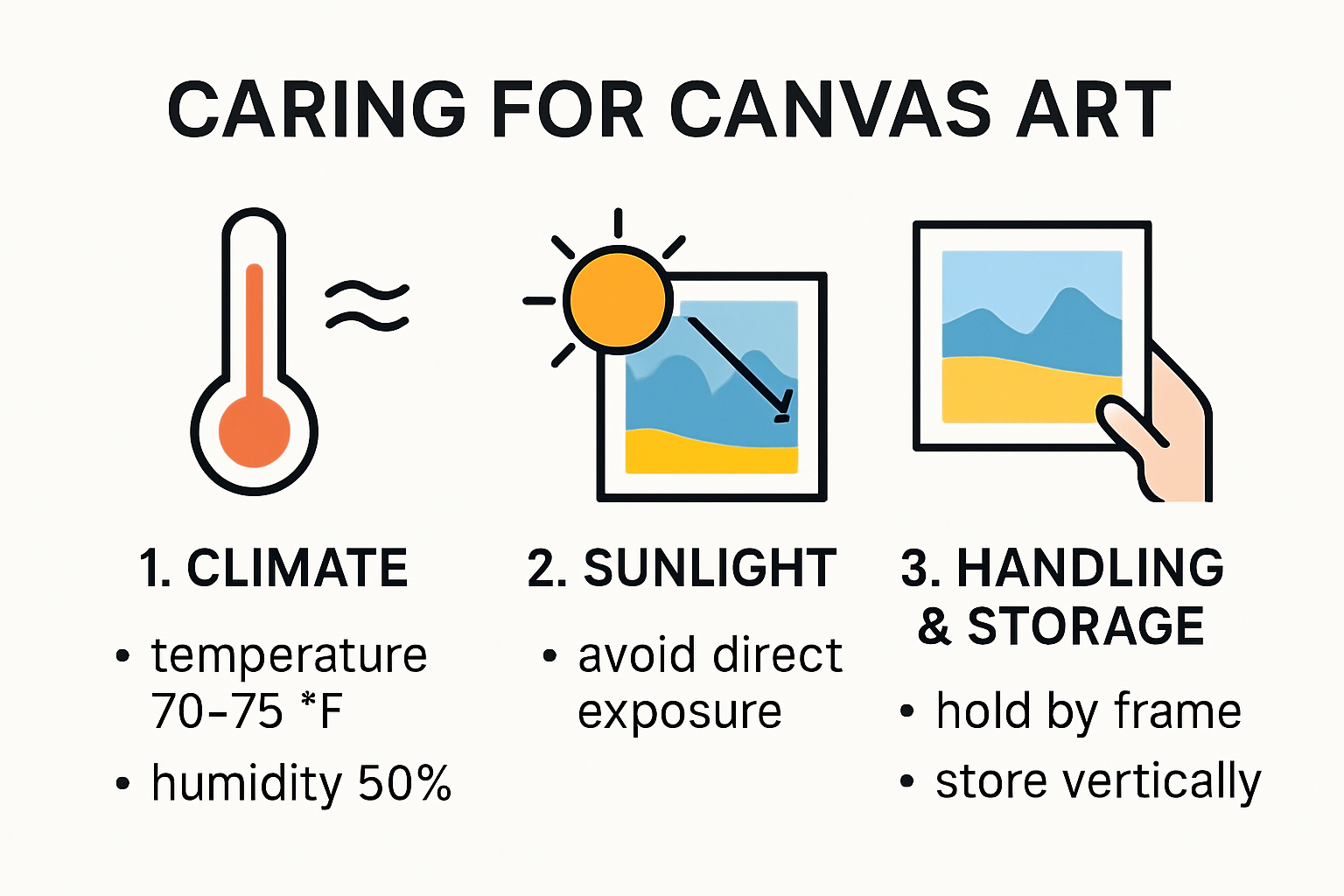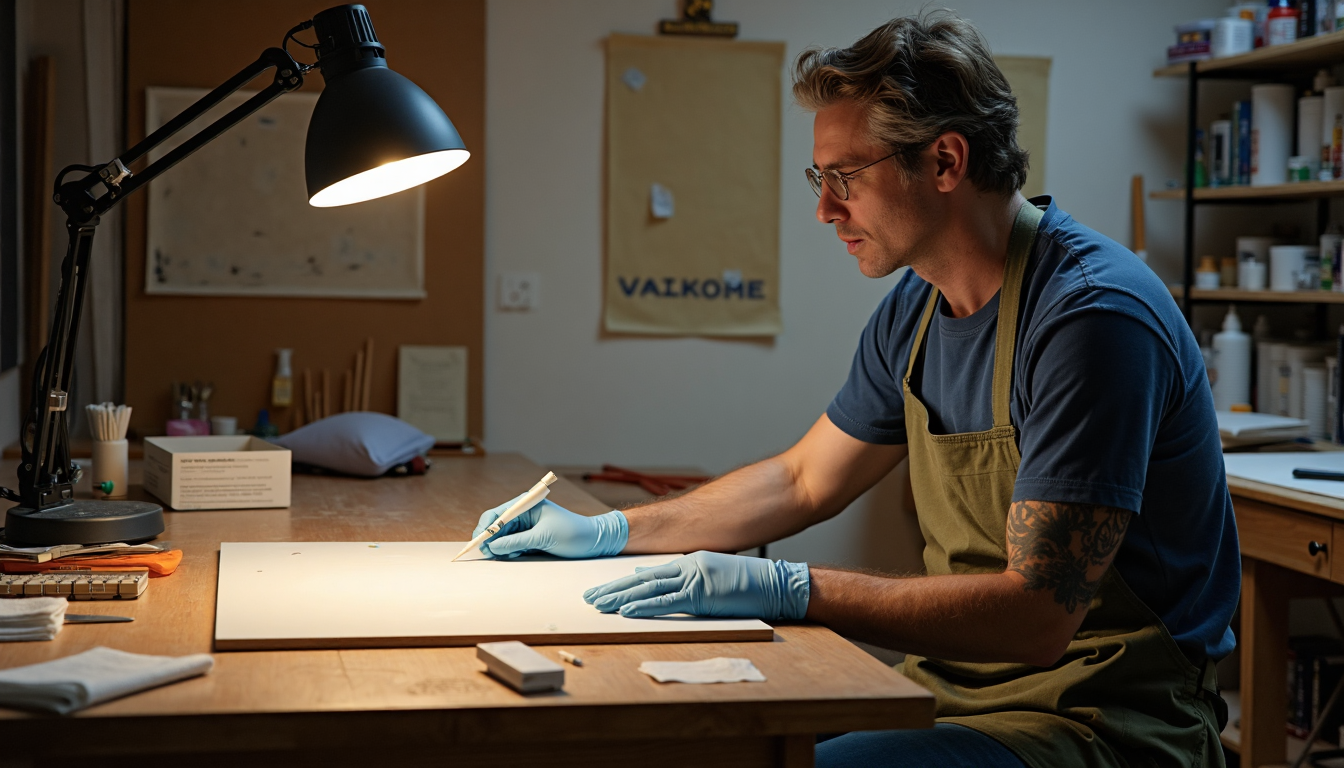
Caring for Canvas Art: Expert Tips for Wall Decor 2025

Canvas art is more than just wall decor—it is a statement that brightens up your space and can even appreciate in value over time. Here is something you might not expect: keeping your artwork in a room with just a 10 degree swing in temperature can speed up canvas deterioration dramatically. Most people think a little dusting and avoiding spills are enough, but real protection is all about climate control, storage hacks, and expert care you cannot see at first glance.
Table of Contents
- Understanding The Basics Of Canvas Art Care
- Cleaning Canvas Art Without Damaging It
- Protecting Canvas Art From Sunlight And Moisture
- Long-Term Storage And Display Tips For Canvas Prints
Quick Summary
| Takeaway | Explanation |
|---|---|
| Optimal Environmental Conditions | Maintain a consistent temperature of 65-70°F and humidity levels around 50-55% to prevent canvas art deterioration. |
| Gentle Cleaning Techniques | Use soft, lint-free cotton gloves and microfiber cloths for dust removal; avoid liquid cleaners and abrasive materials. |
| Proper Artwork Placement | Position artwork away from direct sunlight and use UV-filtering materials to minimize damage from UV radiation. |
| Strategic Storage Methods | Store canvas prints vertically in stable, climate-controlled environments with acid-free wrapping to prevent warping and degradation. |
| Professional Conservation | Seek professional advice for specialized care and cleaning to prevent irreversible damage to valuable artwork. |

Understanding the Basics of Canvas Art Care
Canvas art represents more than just a decorative element. It’s a delicate investment that requires thoughtful care and attention. Preserving the beauty and integrity of your artwork demands understanding the fundamental principles of canvas art maintenance.
Environmental Considerations for Canvas Preservation
The environment plays a critical role in protecting canvas artwork. According to Te Papa Museum’s Conservation Guidelines, maintaining a stable environment is crucial for preventing artwork deterioration. Temperature and humidity fluctuations can cause significant damage to canvas materials.
Key environmental factors include:
- Consistent temperature between 65-70 degrees Fahrenheit
- Relative humidity maintained around 50-55%
- Minimal direct sunlight exposure
Ultraviolet light represents a serious threat to canvas artwork. Prolonged sun exposure can cause pigment fading and material degradation. Professional conservators recommend positioning artwork away from direct sunlight and using protective UV-filtering glass or acrylic when framing.
Handling and Cleaning Techniques
Proper handling is essential for preserving canvas art. Smithsonian Museum’s Conservation Institute emphasizes the importance of minimizing direct contact with artwork surfaces. When moving or cleaning canvas pieces, always follow these expert guidelines:
- Use clean, lint-free cotton gloves
- Support the entire canvas frame when lifting
- Avoid touching painted surfaces directly
- Use soft, dry microfiber cloths for gentle dust removal
For deeper cleaning, professional art conservators recommend periodic professional assessment. Amateur cleaning attempts can potentially cause irreversible damage to delicate canvas surfaces.
Long-Term Canvas Art Preservation
Long-term preservation requires strategic planning and consistent care. Professional art collectors understand that protecting canvas artwork involves more than occasional maintenance. Learn more about protecting your canvas prints with specialized storage techniques that prevent potential degradation.
Storage recommendations include:
- Climate-controlled environments
- Acid-free archival materials
- Vertical storage with proper support
- Regular inspection for potential damage
Understanding these fundamental principles of canvas art care helps collectors protect their valuable investments. By implementing careful handling, maintaining stable environmental conditions, and seeking professional guidance when needed, art enthusiasts can ensure their canvas pieces remain vibrant and beautiful for generations.
Remember that each artwork is unique and may require specialized care. When in doubt, consult a professional art conservator who can provide personalized advice tailored to your specific canvas artwork.

Cleaning Canvas Art Without Damaging It
To help summarize the gentle cleaning techniques and tools recommended for safe dust removal, here is a quick reference table.
| Cleaning Tool | Recommended? | Notes |
|---|---|---|
| Soft Bristle Brush | Yes | Clean, soft-haired, sweep in one direction |
| Microfiber Cloth | Yes | Use lightly, dry only, avoid pressure on painted areas |
| Cotton Gloves | Yes | Wear during handling to avoid direct skin contact |
| Feather Duster | No | Can scratch and transfer contaminants |
| Wet Cloth | No | Moisture can damage pigment/layers |
| Harsh Chemicals | No | May irreversibly damage artwork |
Cleaning canvas art requires precision, patience, and a delicate touch. Improper cleaning techniques can permanently damage your valuable artwork, making professional guidance essential for maintaining the integrity of your canvas pieces.
Understanding Canvas Surface Sensitivity
Canvas art surfaces are remarkably fragile and respond poorly to aggressive cleaning methods. Canadian Conservation Institute emphasizes that direct contact and moisture can cause irreversible damage to artwork. The painted surface contains intricate pigments and delicate layers that can easily deteriorate with inappropriate cleaning approaches.
Professional conservators recommend minimal intervention when maintaining canvas art. This means avoiding liquid cleaners, harsh chemicals, or abrasive materials that could compromise the artwork’s structural integrity. Understanding the nuanced nature of canvas surfaces is the first step in effective preservation.
Gentle Dust Removal Techniques
Dust accumulation represents the primary maintenance challenge for canvas art. According to Conservation Research Guidelines, proper dust removal requires specialized tools and techniques:
- Soft Bristle Brushes: Use clean, soft-haired brushes specifically designed for artwork
- Minimal Pressure: Gently sweep dust using light, uniform strokes
- Consistent Direction: Move the brush in one consistent direction to prevent dust embedding
- Frequency: Dust every 6-12 months, depending on environmental conditions
Important caution: Never use household dusting tools like feather dusters or fabric cloths, which can scratch or transfer additional contaminants to the canvas surface.
Professional Cleaning and Restoration
For comprehensive canvas art maintenance, professional intervention becomes crucial. Learn more about protecting your canvas prints to understand the complexities of artwork preservation.
Professional conservators offer specialized services including:
- Detailed Surface Assessment
- Advanced Cleaning Techniques
- Structural Restoration
- Humidity and Environmental Recommendations
While DIY cleaning might seem cost-effective, amateur attempts can result in permanent artwork damage. Professional conservators possess the expertise, specialized tools, and understanding of different canvas materials to safely clean and preserve your artwork.
Remember that each canvas piece is unique. Factors like age, paint type, canvas material, and environmental exposure influence cleaning requirements. When uncertain, always consult a professional art conservator who can provide tailored advice specific to your artwork’s individual characteristics.
By approaching canvas art cleaning with respect, knowledge, and professional guidance, you can maintain the beauty and value of your cherished pieces for years to come.
Protecting Canvas Art From Sunlight and Moisture
To clarify the best protective measures against sunlight and moisture, this summary table highlights recommended strategies and their benefits.
| Protection Strategy | Targeted Threat | Benefit |
|---|---|---|
| UV-Filtering Glazing | Sunlight/UV | Minimizes fading/pigment breakdown |
| Window UV Films | Sunlight/UV | Reduces harmful UV infiltration |
| Strategic Placement | Sunlight/UV | Prevents prolonged direct exposure |
| Humidity Control | Moisture | Prevents warping, mold, and cracking |
| Dehumidifiers | Moisture | Removes excess ambient dampness |
| Rigid Backing Boards | Both | Shields from environmental changes |
Canvas art represents a delicate investment that requires strategic protection from environmental threats. Sunlight and moisture pose significant risks to artwork preservation, potentially causing irreversible damage to valuable pieces.
Understanding UV Radiation Damage
Ultraviolet radiation represents a silent destroyer of canvas artwork. Canadian Conservation Institute highlights that prolonged sun exposure can cause progressive and permanent color degradation. Pigments break down under continuous UV light, leading to fading, discoloration, and structural weakening of canvas materials.
Protective strategies against UV damage include:
- UV-Filtering Glazing: Use specialized acrylic sheets designed to block harmful radiation
- Strategic Placement: Position artwork away from direct sunlight
- Window Treatments: Install UV-absorbing films on windows near artwork displays
- Rotate Artwork: Periodically change artwork locations to minimize consistent light exposure
Moisture Control and Environmental Stability
Moisture represents another critical threat to canvas artwork preservation. Museum Conservation Guidelines recommend maintaining precise environmental conditions to prevent potential damage.
Key moisture management principles include:
- Consistent Humidity: Maintain relative humidity between 45-55%
- Temperature Control: Keep ambient temperature between 15-25 degrees Celsius
- Avoid Fluctuations: Prevent humidity and temperature changes exceeding 4-5% within 24 hours
- Dehumidification: Use professional-grade dehumidifiers in potential problem areas
Advanced Protective Techniques
Professional conservators recommend additional protective measures for long-term artwork preservation. Learn more about protecting your canvas prints to understand comprehensive preservation techniques.
Advanced protection strategies include:
- Rigid Backing Boards: Install protective backing to shield artwork from environmental variations
- Climate-Controlled Storage: Use specialized storage solutions during non-display periods
- Professional Assessments: Schedule periodic evaluations by art conservation experts
- Archival-Quality Framing: Invest in frames with integrated protective features
Understanding these nuanced protection strategies helps art collectors safeguard their valuable canvas pieces. Each artwork possesses unique characteristics that influence its vulnerability to environmental factors. Professional consultation can provide tailored advice specific to individual pieces.
Remember that prevention is always more effective than restoration. By implementing thoughtful protection strategies, you can preserve the vibrancy, structural integrity, and value of your canvas artwork for generations to appreciate.
Long-Term Storage and Display Tips For Canvas Prints
Below is a summary table outlining top storage and display do’s and don’ts for canvas art based on professional guidelines in the section.
| Practice | Do | Don’t |
|---|---|---|
| Storage Location | Central closets | Basements, attics |
| Storage Orientation | Vertical | Stacked flat |
| Wrapping Material | Acid-free | Standard paper, plastic |
| Backing Board | Rigid, archival | None or flimsy |
| Display Lighting | Indirect | Direct sunlight |
| Room Conditions | Humidity/Temp. controlled | Fluctuating/moist/dry extremes |
| Rotation/Inspection | Regular | Never or seldom |
Preserving canvas prints requires strategic planning and meticulous attention to storage and display conditions. Art collectors understand that proper preservation extends beyond immediate care and encompasses long-term conservation strategies.
Optimal Storage Environment
Canadian Conservation Institute emphasizes the critical importance of selecting appropriate storage locations for canvas artwork. Avoiding extreme environmental conditions is paramount to maintaining artwork integrity.
Key storage recommendations include:
- Central House Location: Store artwork in interior closets with stable temperatures
- Vertical Storage: Position canvas prints vertically to minimize potential warping
- Protective Wrapping: Use acid-free archival materials for individual artwork protection
- Avoid Problematic Areas: Eliminate storage in damp basements or extremely dry attics
Professional conservators recommend implementing a protective backing board made of rigid materials like corrugated plastic. This technique helps reduce environmental fluctuations and provides an additional layer of physical protection.
Display Considerations for Canvas Prints
Displaying canvas prints requires thoughtful placement and ongoing maintenance. Professional conservation guidelines suggest creating an environment that minimizes potential damage while maximizing aesthetic appeal.
Strategic display techniques include:
- Consistent Temperature: Maintain room temperatures between 65-75 degrees Fahrenheit
- Humidity Control: Keep relative humidity around 50-55%
- Indirect Lighting: Use soft, diffused lighting to prevent direct radiation exposure
- Regular Rotation: Periodically change artwork locations to distribute potential light damage
Advanced Preservation Strategies
Explore innovative canvas print display techniques to enhance both preservation and visual presentation. Professional art conservators recommend comprehensive approaches that balance aesthetic requirements with long-term artwork protection.
Advanced preservation strategies encompass:
- Climate-Controlled Frames: Invest in specialized framing with integrated environmental controls
- Professional Assessment: Schedule periodic evaluations by art conservation experts
- Documented Condition Tracking: Maintain detailed records of artwork condition over time
- Specialized Transportation: Use professional art handling techniques during relocation
Understanding that each canvas print possesses unique characteristics is crucial. Factors such as pigment type, canvas material, and previous environmental exposure influence preservation requirements.
Remember that proactive conservation represents the most effective strategy for maintaining artwork value. By implementing these comprehensive storage and display recommendations, collectors can ensure their canvas prints remain vibrant, structurally sound, and visually captivating for generations.
When uncertain about specific preservation techniques, always consult a professional art conservator who can provide personalized guidance tailored to your unique artwork collection.
Frequently Asked Questions
How should I store canvas art to prevent damage?
Store canvas art in a climate-controlled environment, upright and in acid-free wrapping to avoid warping and degradation.
What is the ideal temperature and humidity for preserving canvas art?
Maintain a consistent temperature between 65-70°F and humidity levels around 50-55% to protect your canvas art.
How do I clean my canvas art without causing damage?
Use soft, lint-free cotton gloves and a dry microfiber cloth for dust removal. Avoid liquids and abrasive materials.
How can I protect my canvas art from sunlight?
Position your artwork away from direct sunlight and consider using UV-filtering glass or acrylic when framing your canvas art.
Transform Canvas Care Into an Artistic Investment
You love the vibrance and emotion that a well-chosen canvas brings to your space. Yet, as you read about the risks of fading colors, warping, and delicate surfaces, you may realize your current wall decor needs more protection and expert insight than a quick dust or a hasty relocation can offer.
The pain points are real. Temperature swings, poor storage habits, and sunlight exposure can silently ruin cherished artwork. If your passion for collecting beautiful pieces is matched by a worry about how to display and preserve them—especially high-quality canvas prints—look no further.

Ready to build a collection that lasts for generations? Marta Ellie crafts each canvas print with the same care professionals recommend for long-term preservation. Every piece is created to shine in your space while offering the durability you expect from true investment art.
Visit Marta Ellie’s website to explore collections made for living rooms, city lofts, or new homes, all curated with expert protection and artistry in mind. Take the next step to safeguard your walls with art that is both beautiful and resilient. Shop today and protect your passion from the very start.
Recommended
- How to Choose Art for Living Room Walls: 2025 Guide – Exclusive Canvas Art
- How to Display Canvas Prints: Fresh Ideas for Modern Walls 2025 – Exclusive Canvas Art
- Living Room Wall Art Trends 2025: Modern Canvas and Print Ideas – Exclusive Canvas Art
- How to Store Canvas: Protect Modern Art & Luxury Prints 2025 – Exclusive Canvas Art
- What Is Canvas Print? Modern Wall Art for Stylish Spaces 2025 – Exclusive Canvas Art
- Storytelling Through Art: Wall Decor Ideas for 2025 Collectors – Exclusive Canvas Art